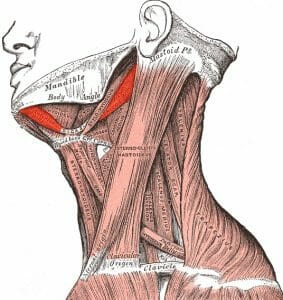Digastric Muscle Definition
The digastric muscle is one of few muscles containing separate muscle bellies. These two parts of the digastric muscle are separated by an intermediate rounded tendon, running through the hyoid bone. There is a digastric muscle on each side of the jaw, connecting from the jaw through the hyoid to the lower part of the skull. This complex arrangement allows for pulley actions on the jaw, and work in concert with the other muscles of the jaw to complete complex motions like chewing, speaking, and breathing. Pain associated with the digastric muscle can often be misplaced due to the complex nature of the nerves involved with the muscle.
Digastric Muscle Structure
The digastric muscle connects to the mandible, or jaw bone, at a place called the symphysis menti. This small ridge is at the middle of the jaw and connects to many muscles, including a digastric muscle on the left and one on the right. The anterior belly of the muscle runs from the jaw to the tendon that separates the two bellies. The tendon attaches to the hyoid bone, and allows tension to be transferred from either belly along the path of the muscle. The posterior belly of the muscle connects this intermediate tendon the temporal bone of the skull. This bone is on the base of the skull and has a small notch, the mastoid notch, where the posterior belly attaches. The anterior belly of the muscle is served by the trigeminal nerve, whereas the posterior belly attaches to the facial nerve. The digastric muscle is highlighted in the image below.
Function of the Digastric Muscle
Unlike most muscles, the digastric muscle can contract in two different portions. Because the bellies of the muscle are supplied by different nerves, the muscles can contract separately. While the exact workings of the face and jaw muscles are very complicated, the digastric muscle works as a kind of tension pulley to generate forces in different directions on the jaw. There are two digastric muscles, one on the left and right, which attach to the lower skull through a pulley mechanism at the hyoid bone. This means that the contraction of this muscle can produce forces which open the jaw and wiggle it from side-to-side. The digastric muscle is thus responsible for actions such as speaking, chewing, swallowing, and breathing. Any complex action of the jaw will likely involve the muscle in some way.
Digastric Muscle Pain
The digastric muscle is often pinpointed as the source in people experiencing jaw, throat, tooth, and general facial pain. The muscle, having two portions separately innervated by different branches of cranial nerves and operating a complex tendon pulley, is prone to tense up. Unfortunately, tension in the anterior belly of the muscle and tension in the posterior belly do not produce the same sensation. The posterior belly is connected to the facial nerve. The anterior belly is connected to the trigeminal nerve, which connects to different parts of the face and jaw than the facial nerve. Thus, any tension in either part of the muscle can send pain impulses through many parts of the face and jaw. Relaxing the muscle with some simple jaw movements and light massage should ease the tension and reduce the pain, even if it feels like it is not coming from the digastric muscle.
Quiz
1. Humans and cats have a digastric muscle, but jawless lampreys do not. Why?
A. The muscle moves the jaw
B. The muscle is needed to make noise
C. Only predators need a digastric muscle
2. In a strange birth defect, a baby is born without a digastric muscle. Which of the following would NOT be a symptom of this defect?
A. Trouble swallowing, breathing, or talking
B. Slightly enlarged neck muscles
C. Inability to hold the head up
3. In an accident involving electricity and a dare from a friend, Jimmy temporarily paralyzed his facial nerve. How will this affect his digastric muscle?
A. No effect
B. The posterior belly will be paralyzed
C. The anterior belly will be paralyzed
References
- De luliis, G., & Pulera, D. (2007). The Dissection of Vertebrates. Amsterdam: Academic Press.

